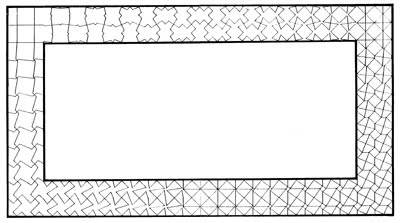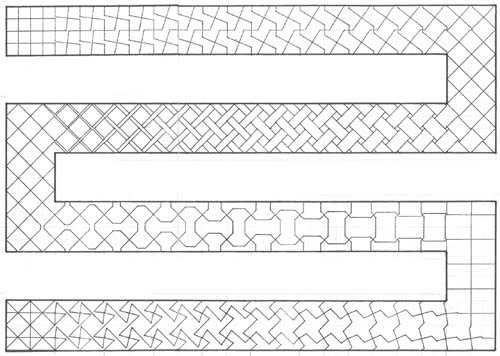Introduction
First, this initial page on parquet deformation largely serves as a general guide and signpost to a series of dedicated subpages on specific aspects of the subject. I begin here with a few generalities, such as defining (as the term is not an obvious description, as well as not being familiar to many mathematicians), how to view, a history, architectural practitioner interest, formats, aesthetics, a request, followed by some parquet deformations of my own. Since its instigation, in 2009, the initial page has undergone many changes, with changes of mind in its presentation. Sometimes it expanded, before being streamlined again, before yet more expansion and streamlining, as deemed suitable of the day. One aspect that has remained constant throughout though is the exemplary (15) parquet deformations, which, as intended, of a core linear premise, followed by variations of the theme, in various formats, serve as a general guide as to possibilities.
My interest in parquet deformation is long-standing, going back to my earliest days of interest in tessellation, in 1987. My introduction to the subject arose from Douglas Hofstadter's 1983 article in Scientific American, 'Parquet Deformations: Patterns of Tiles That Shift Gradually in One Dimension', this being the first popular account. Suitably impressed, I then designed examples of my own, by hand. This is reflected in the instances shown below. Since then I have returned to the subject at intervals, but not essentially being reflected on the page. However, since 2021, upon a proposed article for a book by Werner Van Hoeydonck (that was never realised), this caused me to rethink the subject in general as well as turning to the computer to draw. This rethink spawned numerous essays (16) and new work, as shown by the subpages. In short, the examples below are now a little outdated, being relatively crude in their execution, relatively limited in format, within the limitations of being hand-drawn. Also, these are relatively simple, again due to the restrictions of being hand-drawn. Having largely been redrawn on the computer (1-12), arguably, these could now be dispensed with, as I now have a dedicated page of my latter-day work, but given their historical connection to the page, I have decided to retain. Further, another reason for retaining is that being the main page, these show up on Google searches, whereas the subpages typically do not.
Defining
First, what exactly is a ‘parquet deformation’, and what is its relation to tessellation? At first glance it has no obvious reference or connection to tessellation matters, with the obvious thought of it referring to flooring per se. Indeed, the term and concept may be wholly unfamiliar to most people, even with an interest of tessellations, which I shortly detail. Such an aspect of tessellation has received relatively scant coverage, and in my opinion disproportionately so as to its inherent worth; the effect is most gratifying. Therefore, to clarify such matters, I now define a parquet deformation as a ‘geometrical tessellating metamorphosis’, usually shown as a ‘long strip’ of a horizontal presentation (although other formats are possible), of which the tiling changes, subtly so at each alternate stage, almost inconsequentially so, but drastically so when seen from beginning to end; the beginning and end tiles bearing no relation to each other.
Viewing
As such, in contrast to any ‘orthodox' picture, for example a portrait or landscape, or indeed a tessellation in the ‘normal’ sense, with the eye wandering ‘at whim’, a parquet deformation is not intended to be viewed in a generalised sense, but is instead intended to be read in a specific way. For the commonly to be seen strip, as detailed above, this is then ‘scanned' by the eye, in a left to right or vice versa direction, as in reading a line of text. Whereupon having so done, a given tiling thus can be seen to gradually metamorphosis in outline, until upon ‘completion' of its metamorphosis it is unrecognisable from its beginning.
Architectural Practitioner Interest
An interesting observation as to design matters is that of the connection with the field of architecture rather than that of the perhaps more obvious one of mathematics and specifically tessellation. Indeed, the architecture connection is evident from the very beginning, with the founder, William Huff. Subsequent to his work, there have also been other architects with an interest, such as Tuğrul Yazar, Werner Van Hoeydonck and Gunter Henn. Perhaps somewhat surprisingly, despite an obvious link to tessellation, there are relatively few mathematically inclined people with an interest. Instead, mathematicians seem to take a (generally) brief interest as a result of their studies in general. Craig Kaplan is perhaps the obvious exception. An open question, therefore, is what makes this topic of interest to architects? The disciplines seem somewhat disparate, at least at first glance.
Formats
As alluded to above, different formats are indeed possible, and not just the ‘usual’ portrayal of the long strip. Indeed, the only limit is one’s imagination. Frequently seen are square blocks, and for the sake of variety, I show a long strip; albeit this wasn’t thought through at the time; it is lacking in aesthetics. I also show a rectangular loop, of which in principle this is merely four parquet deformations butted together and then bent to form the loop. Furthermore, one is not necessarily confined to a square based; equilateral triangles can also be used.
Aesthetics
What I term as aesthetics is a most important part of parquet deformations, in that this determines the quality. This is a vital aspect of parquet deformations and is too often neglected. As alluded to above, since Huff’s day, the computer has in effect stormed the world of design and is being used more and more, to the exclusion of hand drawings. Indeed, with the advent of this tool, it opens up new possibilities that simply are impractical by hand; different formats, more complex examples. it also has the potential of time-saving; drawing by hand can indeed be laborious Be that as it may, what still counts is the inherent quality or aesthetics of the design. What makes for a ‘good’, or indeed ‘bad’ parquet deformation? As a basic statement, those by Huff’s students serve as this model; they possess a degree of ‘elegance’ that others in this field do not possess. And I might add that mine do too, but differently subtly from Huffs. Huff’s instances can be broadly divided into two types (a) those that evolve into simple geometric tiles: e.g. Crossover, Dizzy Bee, Consternation, and (b) those that more involved final tile, such as Crazy Cogs, Arabesque, Curracha. In contrast, mine are all ‘simple’ geometrical tiles, such as a right-angled triangle to a rectangle (No. 1). Another important aspect is the tempo. By this, I mean that the changing of the tiles should be neither too ‘quick’ nor ‘slow. A quick example would be where the change is too drastic, of just a cycle of say, two or three stages. Here, the change would be too quick for the eye to view. Slow would say, one hundred, where change is imperceptible at each stage, and so would make for tedious viewing.
A feature of this way of designing is that the finished deformation is not predictable, resulting in a pleasing surprise upon completion. As a rule, I favour a simple beginning, typically of a square, as this acts as a fundamental aspect, in contrast to an arbitrary geometrical shape. A different type of approach is to begin and end a deformation with a certain polygon or geometrical shape in mind. Some examples of this include the Laves tilings, where Craig Kaplan [5] show this. Note that mostly in contrast to the Huff examples, mine can in a sense be continued; for example, No.4 can be butted on to No.1, which can, in turn, be butted with No.5, and so on. Mine are broadly of a self-contained nature, with a beginning, middle and end, where typically they begin quietly, ‘came to life’ in the middle, before fading towards the end. In essence, each of these is a one-off, albeit as alluded to above, can indeed be joined if so desired. In contrast, Craig Kaplan’s are more of an ‘all-encompassing’ approach. For instance, he set himself the challenge of combining all suitable Laves tilings as parquet deformations and met with success.
Requests
However, despite the above ‘revival', such as it is, somewhat disappointingly I still find so few people undertaking new examples or who are at least interested in this aspect of tessellation, and so I would be more than interested in hearing from fellow enthusiasts on this matter, especially from the ex-students' of Huff's. Of especial interest would be to make contact with the designers of the parquet deformations in the Scientific American article and other publications. If you are one of these people reading this, please do step forward! A full listing is given on the dedicated page 'People'.
Some of my own examples are shown below.
No.1
(Not a parquet deformation as according to Huff's rules)
No. 2
(Not a parquet deformation as according to Huff's rules)
No. 3
(Not a parquet deformation as according to Huff's rules)
No. 4
(Not a parquet deformation as according to Huff's rules)
No. 5
No. 6
No. 7
No. 8
No. 9
No. 10
No. 11
No. 12
(Not a parquet deformation as according to Huff's rules)
Page History
2009
29 September. First incarnation.
2014
Created 17 April 2014. Previously (29 September 2009), the material was over three pages, of which I now show as a single page, complete with further, additional text
2016
30 November. References greatly expanded, replacing the previous six entries with minor commentary text with thirty-two entries, and all with further, extensive commentary and detail.
2017 (12 August 2021 - Content moved to a dedicated page; 'Other People')
16 May. Werner Van Hoeydonck text and image added
12 June. Edmund Harriss video added
2018 (12 August 2021 - Content moved to a dedicated page; 'Other People')
27 August. Mamoun Sakkal detailed text and image added
31 August. Alvy Ray Smith and Norman Courtney detailed text and image added
7 September. Craig Kaplan detailed text and images added
11 September. Yazar Tuğrul detailed text added
12 September. Werner Van Hoeydonck detailed text added
20 September. Edmund Harriss detailed text added
24 September. David Oleson detailed text added
25 September. John Sharp detailed text added
2019 (12 August 2021 - Content moved to a dedicated page; 'Other People')
9 May. Douglas Blumeyer detailed text and images added
2021
12 August. Page streamlined to an extent, with existing material placed on a new dedicated page (Other People). An initial listing of Huff's ex students now has been assimilated into an existing enlarged, dedicated page (People).
13 August. Wrote a new, dedicated introduction, oddly lacking before, with the streamlining above in mind.
27 August. Removed a brief 14-line section on its history (non-illustrated), upon this date of having composed a dedicated, subpage of a more considered piece of writing in all aspects.














